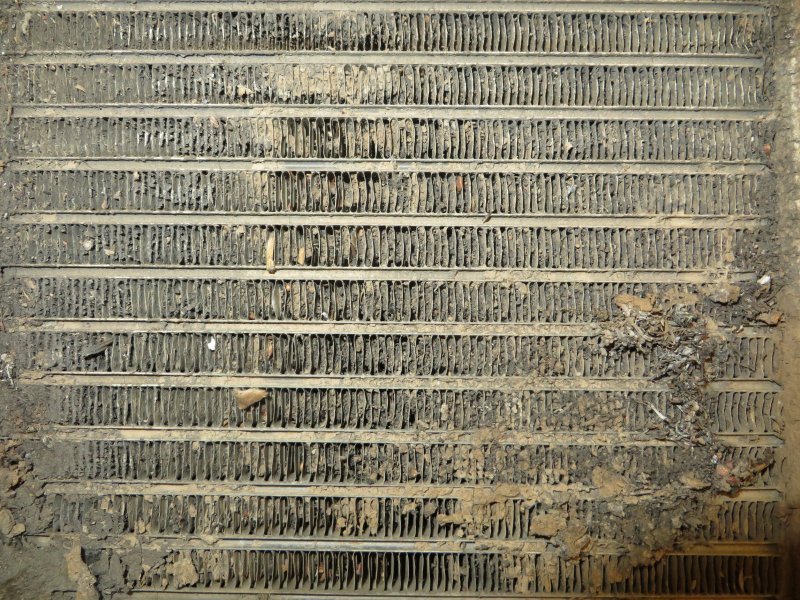It's been very warm... okay down right HOT in the northeast here as of late.
Yesterday, after suffering a blow out of an o ring on the new lines I installed two months ago, I recharged the system. Name plate charge in the system, and off we go.
We were operating in large family time, aka, running behind schedule. I had just fixed the line, left it in high idle to cool it down and then we left.
It was not cool. Drove for a while, still not cool. It was blowing "cool" air, but not the COLD air that you need to keep comfortable.
So, I tore into it last night.
I didn't have a high side fitting to check the head pressure of the system, but I knew that the suction pressure and it was HIGH. This is a new compressor less than a year old and pumps well. Suction pressure was around 50-55psi. I checked the liquid line temp coming off of the condenser. Now, it was about 85° last night when I was working on this. The liquid line temp was 130°F!!! This means one thing... the condenser is not giving up it's heat.
Now, in the HVAC trade, one of the ways we quickly check air flow on condenser fan motors (propeller blade style) is too see if the air comes directly out the back of the fan, or comes of the outer tips of the blades. If it's the tips of the blades (in our trucks, that would be blowing upward off the fan, and not blowing backward toward the engine) this means that the fan is struggling to get air flow through the radiator, condenser, etc.
I pulled as much as I could apart, and cleaned it carefully with my condenser coil cleaners. There was no "mat" of bugs and dirt. The dirt was buried within the fins themselves. A blast of water with the garden hose backward (engine side) of the radiator will help push some dirt out, but you really should have some type of detergent to help clear and clean the coil.
After reassembly, the liquid temperature (dry not still wet, 'cause that would be cheating) was 85°F. That's nearly 45° improvement over what I started with. The condenser coil itself was relatively okay, but since the radiator stood between it and the fan, air flow lacked.
I brag now, but we will see what the day brings with the heat again and recheck performance.
So, for those who may be struggling with some temperature problems, either AC or engine.... things to consider about air flow. Check to see if the air flow is coming off the tips of the blades or blowing backward toward the engine.
Yesterday, after suffering a blow out of an o ring on the new lines I installed two months ago, I recharged the system. Name plate charge in the system, and off we go.
We were operating in large family time, aka, running behind schedule. I had just fixed the line, left it in high idle to cool it down and then we left.
It was not cool. Drove for a while, still not cool. It was blowing "cool" air, but not the COLD air that you need to keep comfortable.
So, I tore into it last night.
I didn't have a high side fitting to check the head pressure of the system, but I knew that the suction pressure and it was HIGH. This is a new compressor less than a year old and pumps well. Suction pressure was around 50-55psi. I checked the liquid line temp coming off of the condenser. Now, it was about 85° last night when I was working on this. The liquid line temp was 130°F!!! This means one thing... the condenser is not giving up it's heat.
Now, in the HVAC trade, one of the ways we quickly check air flow on condenser fan motors (propeller blade style) is too see if the air comes directly out the back of the fan, or comes of the outer tips of the blades. If it's the tips of the blades (in our trucks, that would be blowing upward off the fan, and not blowing backward toward the engine) this means that the fan is struggling to get air flow through the radiator, condenser, etc.
I pulled as much as I could apart, and cleaned it carefully with my condenser coil cleaners. There was no "mat" of bugs and dirt. The dirt was buried within the fins themselves. A blast of water with the garden hose backward (engine side) of the radiator will help push some dirt out, but you really should have some type of detergent to help clear and clean the coil.
After reassembly, the liquid temperature (dry not still wet, 'cause that would be cheating) was 85°F. That's nearly 45° improvement over what I started with. The condenser coil itself was relatively okay, but since the radiator stood between it and the fan, air flow lacked.
I brag now, but we will see what the day brings with the heat again and recheck performance.
So, for those who may be struggling with some temperature problems, either AC or engine.... things to consider about air flow. Check to see if the air flow is coming off the tips of the blades or blowing backward toward the engine.

